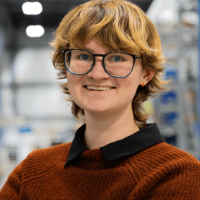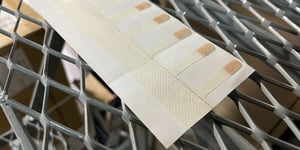Imagine you were at the hospital, and the surgeon grabbed a roll of duct tape to apply a wound dressing. You’d be understandably alarmed!
Aside from the fear of removing the duct tape from your skin, you’d likely wonder whether it was disinfected or if a nurse bought it from the closest home project store.
Different types of tape exist for a reason, and we know there are products built for clinical circumstances. These products don’t have real alternatives because putting duct tape on an open wound is as ridiculous as it would be painful.
You want medical-grade products that patients and healthcare providers can trust, but how can you believe converters when they tell you that you need to use a more expensive product than what you are used to?
Having helped hundreds of different medical adhesive production jobs scale from simplified samples to million-part productions, Strouse is steadfast in our belief that the effectiveness of your medical adhesives relies on the quality of their converting.
Today, we’re going to help you understand why certain tapes need to be processed under strict conditions to guarantee the health and comfort of patients and why it has a higher initial price despite reducing costs in the long term.
The Cost of Medical Tape Converting
Medical tape converting involves transforming tape into rolls, strips, or die cut medical products. These adhesives can be used as wearables, wound dressings, waterproof bandages, and more.
While several steps of medical tape converting are the same as everyday, run-of-the-mill processing, it includes additional measures to uphold patient comfort as well as a sterile environment.
WEARABILITY
While adhesives must be effective enough to stick in place, wearable adhesives risk tearing sensitive skin. Many patients are active, and it’s up to the converter to ensure their adhesives are strong enough to cling to the skin during morning jogs without causing pain or discomfort.
To avoid causing discomfort, many of the materials used to build wearables are soft and conformable, able to flex around different parts of the body, yet the material needs to maintain a certain layer of rigidity, or else it becomes difficult to cut.
MATERIAL COMPLEXITY
Certain materials are more difficult to cut or handle, increasing the price and part complexity.
If your converter wants to produce precise and safe parts, they’ll need to run complex materials at a slower rate. Many medical devices use materials that run slower on a press, increasing converting costs.
Specialized Adhesives: Many of the different bandages and wound dressings in today’s market were produced for a specific purpose, making them specialized adhesives.
While this is great news for doctors and patients, specialized adhesives are made of highly specific materials with a high price tag.
Elasticity: Due to their elasticity, materials like spandex or foam are trickier to process on a die cut press. Too much tension could cause the foam to elongate, resulting in the wrong part tolerances.
In addition, while waste is an inevitable part of the die cutting process, specialized adhesives generate more waste, which factors into the final cost by forcing you to purchase more raw material.
Finding a specialized adhesive that isn’t too expensive isn’t always easy. The right type of medical adhesive tape doesn’t just fit your price range but also could mean the difference between a functioning part and a dud.
ENVIRONMENT
Environment is the highest cost of medical tape converting and its greatest asset.
A medical manufacturing environment, also known as "a cleanroom," has constraints such as temperature, humidity, and particle control, which all require monitoring in the processing space.
However, the act of sterilization is crucial to part usability because any contamination at all renders the parts unusable for patients.
To fully understand the cost of sterile adhesives, you must embrace the cost of maintaining clean conditions and think beyond the cost of your initial die cut. Rather than saving money as you’d hoped when paying a cheaper initial price, you might spend far more on decontamination.
STERILIZATION
Sterilization costs can represent upwards of 50% of the total cost for a manufactured part. “Sterilization” is essentially the treatment of a defined volume of space for a pre-determined amount of time.
The amount of sterilization time required to result in a “sterile” product depends on how much biological contamination, or “bioburden,” is already present. This treatment time is determined through initial sterilization validation testing, which costs $1,000s. Your ultimate sterilization price-per-part is determined using a $/time rate you pay for a particular volume of space to be treated.
Variables that drive die cut sterilization costs include:
- Part size
- Larger parts = fewer parts per treatment = $/part for sterilization
- Batch size
- Partial batches (those not using the maximum volume available for treatment) = fewer parts per treatment = higher $/part for sterilization
- Excessive Product Biological Contamination (bioburden)
- A higher level of contamination = longer treatment times = higher $/part for sterilization
Another cost to consider is that sterilization comes with additional shipping/handling costs resulting from transit to and from the 3rd party sterilization facility.
Sterilization techniques are often performed using an autoclave or other heat-based machinery. Yet, many medical tape adhesives are made of materials susceptible to melting and require alternate methods like ETO gas sterilization or gamma radiation.
This sterilization equipment is highly specialized, meaning converters often aren’t the last line of contamination prevention before your part reaches clinical spaces. Instead, the converter sends the parts off to facilities with proper large-scale tools for sterilization. It’s worth noting factors like part size and batch size will also make up a significant percentage of your total cost.
We recommend that you strongly consider all these factors when determining raw material sources of supply and partnering with your converters or contract manufacturers. The less bioburden added to the product along the supply chain, the less sterilization treatment time is required to sterilize the final product.
Keeping your product as clean as possible BEFORE sterilization saves you money, and the answer lies in sterile manufacturing environments such as an ISO 7 cleanroom.
WHAT IS AN ISO 7 CLEANROOM?
A typical building goes through about 2-4 natural air changes per hour, whereas an ISO 7 cleanroom experiences 30-60 changes.
Different ISO grades determine air cleanliness through average air changes per hour AND maximum particle count.
The ordinary air of a room contains at least 35,200,000 particles per cubic meter, but air from an ISO 7 cleanroom remains under 352,000 particles per cubic meter, meaning our cleanroom is more than 100 times cleaner than a regular space.
Regardless of whether a third party will sterilize the part when your product is built in a cleanroom, it avoids contamination it would gather in ordinary manufacturing spaces.
You might believe you’re saving money by using a regular manufacturer to produce medical tape. Unfortunately, dirtier adhesives must be decontaminated for extended periods, and long sterilization processes cost more money.
Instead of paying for days of gamma-ray or ETO gas treatments, invest in high value parts that require shorter sterilization cycles due to a cleaner manufacturing process.
Should You Choose Medical Tape Converting?
Using a company that promises the lowest price will always be tempting, but what about the additional costs you’ll incur with decontamination?
We’ve had potential clients turn down the opportunity to have their parts produced in a cleanroom only to go on and pay more for sterilization than the actual parts’ worth.
Not to mention, many products can’t risk coming into contact with skin flakes, hair, or other bioburdens.
Once you’ve figured out decontamination, you’ll want to return to the initial cutting process. Die cut parts can be pricey, but if you actively work alongside your converter, it becomes possible to mitigate die cut costs through better material sourcing and efficient part design.
If you’re ready to start your journey of having parts made out of medical tape, request a quote as we begin guiding you through the process. Don’t pay to blast your part with gas or rays at the last minute. Instead, choose the right converter to ensure the quality of your part throughout the entire process.





